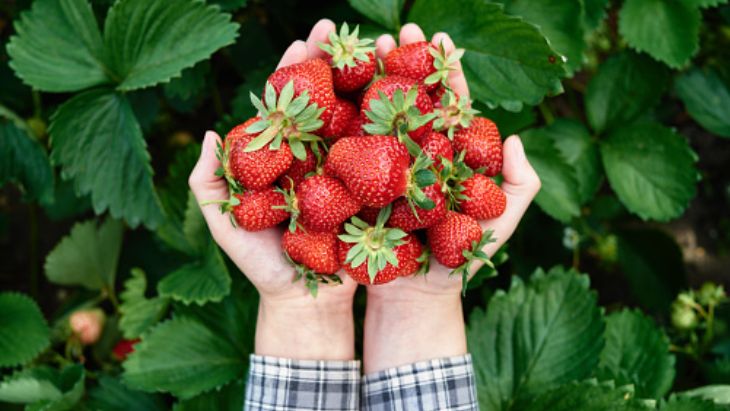Strawberries, with their vibrant red color and sweet juicy taste, are a delightful addition to any garden or even a small balcony. Growing your own strawberries allows you to enjoy the freshest, most flavorful fruits while providing a rewarding gardening experience. Whether you are a seasoned gardener or a beginner, this comprehensive guide will equip you with the knowledge and tips you need to successfully grow and care for strawberries.
How to grow strawberry
Choosing the Right Variety
Selecting the right strawberry variety is crucial for a successful harvest. Consider factors such as climate, available space, and personal preference. There are three main types of strawberries:
- June-bearing: These varieties produce a single large crop in late spring or early summer. Ideal for cooler climates and larger gardens.
- Everbearing: Everbearing strawberries yield two smaller harvests, one in late spring and another in late summer. Suitable for milder climates and smaller gardens.
- Day-neutral: Day-neutral varieties produce fruits continuously throughout the growing season. They are more adaptable to various climates and suitable for both large and small gardens.
Sunlight and Soil Requirements
Strawberries thrive in full sunlight, so choose a location that receives at least 6-8 hours of direct sunlight each day. The soil should be well-draining, rich in organic matter, and slightly acidic (pH between 5.5 and 6.5). If the soil is heavy clay or sandy, consider amending it with compost or well-rotted manure to improve its fertility and drainage.
Planting
- Prepare the soil by removing weeds, rocks, and debris. Dig a hole large enough to accommodate the strawberry plant’s root system.
- Space the plants 12-18 inches apart in rows, leaving about 3 feet between each row.
- Place the crown (where the roots meet the leaves) at the soil surface level. Avoid planting too deep or burying the crown.
- Gently backfill the hole, firming the soil around the roots.
- Water thoroughly after planting to settle the soil.
Watering and Mulching
Strawberries require consistent moisture, especially during fruiting. Water deeply once or twice a week, ensuring the soil remains evenly moist but not waterlogged. Consider using a drip irrigation system to deliver water directly to the plants’ roots while minimizing moisture on the leaves, which can lead to disease.
Apply a layer of organic mulch, such as straw or pine needles, around the plants. Mulching helps conserve moisture, suppress weeds, and prevent soil erosion. It also keeps the berries clean by preventing direct contact with the soil.

Fertilizing
Strawberries are heavy feeders and benefit from regular fertilization. Apply a balanced organic fertilizer, following the manufacturer’s instructions, in early spring before new growth begins. Additionally, side-dress the plants with compost or a nitrogen-rich fertilizer every 4-6 weeks during the growing season to support healthy foliage and fruit production.
Pruning and Maintenance
- Remove any runners (long stems with small plants at the end) that appear, as they divert energy from fruit production. Snip them off to encourage stronger growth.
- Trim back yellowing or damaged leaves to maintain good airflow and reduce the risk of disease.
- Weed regularly to prevent competition for nutrients and water.
- Inspect the plants for pests or diseases, such as aphids or powdery mildew, and take appropriate measures to control them.
Frequently Asked Questions
1. When is the best time to plant strawberries?
The ideal time to plant strawberries depends on your climate. In general, it is best to plant them in early spring, after the last frost date. This allows the plants to establish themselves before the summer heat arrives.
2. Where should I plant my strawberries?
Strawberries prefer a location with full sun exposure for at least 6 to 8 hours a day. Choose a spot in your garden that has well-drained soil, as strawberries don’t thrive in waterlogged conditions. Raised beds or containers can also be suitable options.
3. How do I plant strawberry plants?
Dig a hole large enough to accommodate the plant’s roots, and space the plants about 12 to 18 inches apart. Place the crown (where the leaves emerge) at the soil level and cover the roots gently. Water the plants well after planting to settle the soil around the roots.
4. How should I care for my strawberry plants?
Water your strawberry plants regularly, keeping the soil consistently moist but not waterlogged. Mulching around the plants with straw or pine needles can help retain moisture and suppress weeds. Fertilize the plants with a balanced fertilizer according to the package instructions. Remove any runners (long stems) that develop to prevent overcrowding.
5. How can I protect my strawberries from pests and diseases?
To protect your strawberries from pests like birds, you can use netting or bird scare devices. Regularly inspect your plants for signs of pests or diseases, such as aphids, slugs, or fungal infections. If necessary, use organic insecticides or fungicides to control the problems.
6. When can I expect to harvest strawberries?
The time from planting to harvest depends on the variety and growing conditions. Generally, you can expect to start harvesting strawberries 4 to 6 weeks after the plants bloom. Harvest the berries when they are fully ripe, usually when they have turned bright red and are slightly soft to the touch.
7. Can I grow strawberries in containers?
Yes, strawberries can be successfully grown in containers. Use a container that is at least 8 inches deep and wide enough to accommodate the plant’s roots. Ensure the container has drainage holes, use a well-draining potting mix, and provide adequate sunlight and water for the plants.

